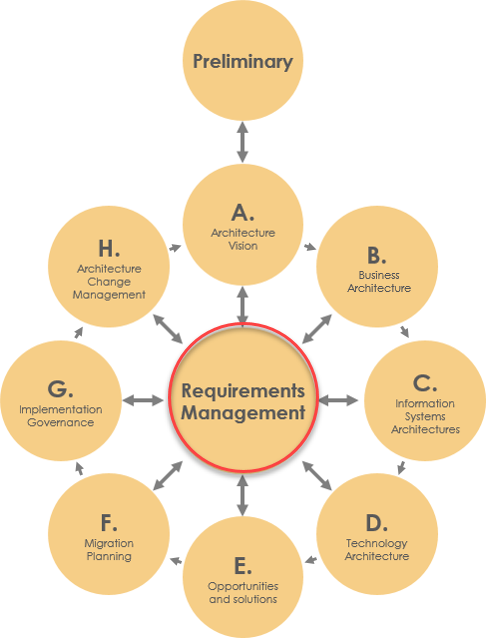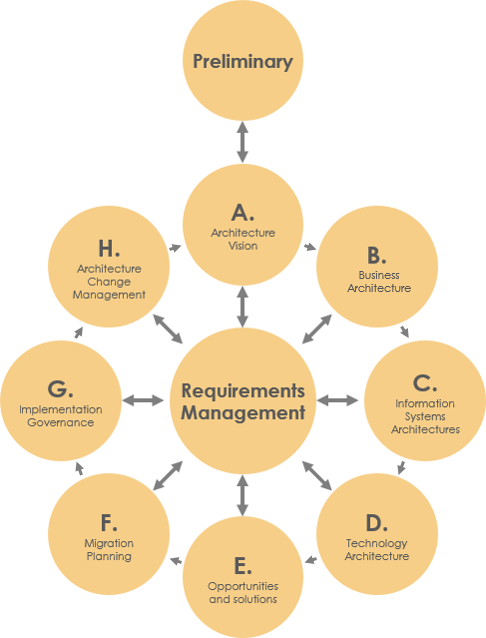Home » Enterprise Architecture
A principle is a general statement that guides and constrains the decision-making and behavior of an organization or enterprise. It reflects the organization's values, goals, and priorities, and helps to ensure that all decisions and actions are aligned with its vision and mission. Enterprise principles provide a high-level set of guidelines for designing and implementing enterprise solutions. These principles help to ensure that all solutions align with the organization's goals, strategy, and values, while also facilitating consistency and interoperability across different architecture domains. Developing effective architecture principles requires a deep understanding of the…
continue reading →
TOGAF, or The Open Group Architecture Framework, is a widely adopted framework for enterprise architecture. One of its key components is the Architecture Development Method (ADM), which provides a structured approach to creating and managing enterprise architectures. Governance plays a crucial role in TOGAF, ensuring that architecture development aligns with organizational goals and standards. In this tutorial, we will explore how TOGAF deals with governance and its relationship with the processes in the ADM. 1. Understanding Governance in TOGAF Governance in TOGAF refers to the process of establishing and maintaining control over the…
continue reading →
Introduction In the ever-evolving landscape of enterprise architecture, The Open Group Architecture Framework (TOGAF) offers a structured approach known as the Architecture Development Method (ADM). At the heart of this framework lies a critical element: governance teams. These teams play a pivotal role in ensuring that the architecture development process remains effective and aligned with an organization's overarching goals and standards. In this discussion, we delve into the key responsibilities and contributions of governance teams across each phase of the TOGAF ADM. The Vital Role of Governance Teams in TOGAF The TOGAF (The…
continue reading →
Introduction The Open Group Architecture Framework (TOGAF) is a widely adopted enterprise architecture methodology that provides a structured approach to designing, planning, implementing, and managing an organization's enterprise architecture. TOGAF is based on the Architecture Development Method (ADM), which consists of several phases that guide the creation of an enterprise architecture. One crucial phase within TOGAF is the Requirement Management Phase. In this article, we will delve into the Requirement Management Phase's significance, its relationship to the TOGAF ADM, its objectives, the key stakeholders involved, and the formation of teams. We will also…
continue reading →
Introduction The TOGAF (The Open Group Architecture Framework) Architecture Development Method (ADM) is a comprehensive framework that helps organizations design, plan, and implement effective enterprise architectures. Phase E of the TOGAF ADM, known as "Opportunities and Solutions," plays a crucial role in bridging the gap between architectural planning and real-world implementation. In this phase, organizations evaluate potential architectural opportunities and develop concrete solutions to address their business and IT needs. In this article, we will explore the purpose and significance of Phase E and provide examples of how it contributes to successful enterprise…
continue reading →
Introduction In the ever-evolving landscape of enterprise architecture, successful transformation requires meticulous planning and execution. TOGAF (The Open Group Architecture Framework) offers a structured approach to achieving this transformation, and Phase F, known as "Migration Planning," stands as a pivotal stage in this journey. In this article, we will delve into the essential aspects of Phase F, highlighting its significance, objectives, and key activities. By the end of this exploration, you will have a clear understanding of the role Migration Planning plays in the TOGAF ADM and how it propels organizations toward their…
continue reading →
The TOGAF (The Open Group Architecture Framework) Architecture Development Method (ADM) is a comprehensive framework that helps organizations in developing and managing their enterprise architecture. It consists of several phases, each designed to address specific aspects of the architecture development process. Phase G, known as the "Implementation Governance" phase, plays a pivotal role in ensuring the successful implementation of the architecture. Setting the Stage: The State of Affairs in Phase G Phase G comes after the completion of the earlier phases of TOGAF ADM, including Preliminary, Architecture Vision, Business Architecture, Information Systems Architecture,…
continue reading →
Introduction Project management and enterprise architecture are two critical disciplines that play pivotal roles in shaping the success and efficiency of organizations. The Project Management Body of Knowledge (PMBOK) and The Open Group Architecture Framework (TOGAF) Architecture Development Method (ADM) are two widely adopted frameworks that help professionals manage projects and develop enterprise architectures, respectively. In this article, we will delve into the definitions, principles, and key differences between PMBOK and TOGAF ADM, supported by real-world examples to illustrate their applications. PMBOK: Managing Projects Effectively The Project Management Body of Knowledge (PMBOK) is…
continue reading →
Are you tired of struggling with the complexities of Project Management, from the daunting learning curve to the high costs associated with hiring certified professionals? Visual Paradigm has the solution you've been searching for with our groundbreaking PMBOK® tool. Say goodbye to the challenges and hello to streamlined IT project management, all at minimal costs. Out-of-the-Box Project Management in PMBOK Template Navigating the vast landscape of Project Management can be a time-consuming and frustrating endeavor. Hours are wasted searching for relevant information just to take one step forward. Visual Paradigm changes the game…
continue reading →
In today's fast-paced business landscape, successful organizations understand the critical need for Enterprise Architecture (EA). It's the key to transforming fragmented applications and processes, both manual and automated, into an integrated environment. This integration optimizes processes, allowing your organization to swiftly respond to change and achieve its business strategies. But unmanaged complexity in your IT landscape can lead to increased costs and reduced flexibility, characterized by a lack of standards, redundant applications, multiple platforms, and inconsistent data. Alignment between your business strategy and IT initiatives is more crucial than ever. Business transformation is…
continue reading →




